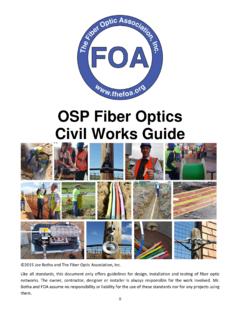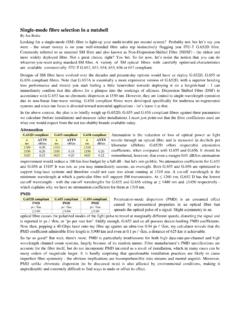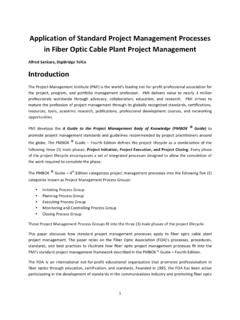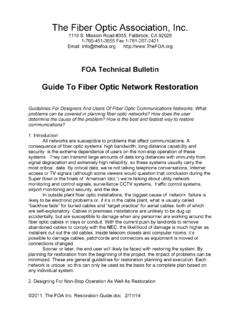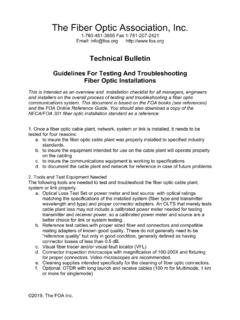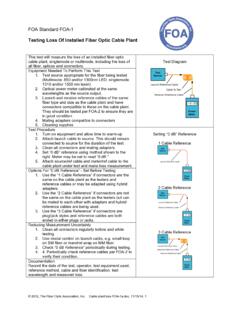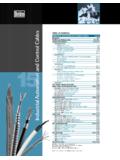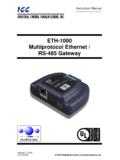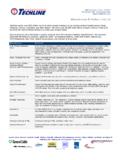Transcription of The Fiber Optic Association, Inc.
1 The Fiber Optic association , Inc. 1119 S. Mission Road #355, Fallbrook, California 92028 USA 1-760-451-3655 Fax 1-781-207-2421 Email: 2014, The FOA 2/26/14 FOA Technical Bulletin Guide To Fiber Optic Network Design Contents Page Part 1 Introduction 1 Part 2 Getting Started 3 Part 3 Copper, Fiber or Wireless? 5 Part 4 Choosing Transmission Equipment 7 Part 5 Planning The Route 9 Part 6 Choosing Components For Outside Plant Installations 11 Part 7 Choosing Components For Premises Installations 13 Part 8 The Link Power Budget 15 Part 9 Documentation 16 Part 10 Planning for the install 18 Part 11 Developing A Test plan 20 Part 12 Planning For Restoration 21 Part 13 Choosing A Contractor 23 Part 14 Managing The Project 26 Part 15 Maintaining The Network 27 Part 16 Cabling Standards 29 Part 1: Introduction What is Fiber Optic network design?
2 Fiber Optic network design refers to the specialized processes leading to a successful installation and operation of a Fiber Optic network. It includes determining the type of communication system(s) which will be carried over the network, the geographic layout (premises, campus, outside plant (OSP, etc.), the transmission equipment required and the Fiber network over which it will operate. Next we have to consider requirements for permits, easements, permissions and inspections. Once we get to that stage, we can consider actual component selection, placement, installation practices, testing, troubleshooting and network equipment installation and startup.)
3 Finally, we have to consider documentation, maintenance and planning for restoration in event of an outage. 2014, The FOA Inc. Design 2/26/14 p2 Design requires working with higher level network engineers usually from IT (information technology) departments and cable plant designers such as the architects and engineers overseeing a major project, as well as contractors involved with building the projects. Other groups like engineers or designers involved in aspects of project design such as security, CATV or industrial system designers or specialized designers like BICSI RCDDs for premises cabling may also be overseeing various parts of the project that involves the design and installation of Fiber Optic cable plants and systems.
4 Designers should have an in-depth knowledge of Fiber Optic components and systems and installation processes as well as all applicable standards, codes and any other local regulations. They must also be familiar with most telecom technology (cabled or wireless), site surveys, local politics, codes and standards, and where to find experts in those fields when help is needed. Obviously, the Fiber Optic network designer must be familiar with electrical power systems, since the electronic hardware must be provided with high quality uninterruptible power at every location. And if they work for a contractor, estimating will be a very important issue, as that is where a profit or loss can be determined!
5 Those involved in Fiber Optic project design should already have some background in Fiber optics, such as having completed a FOA CFOT certification course, and may have other training in the specialties of cable plant design such as electrical contracting apprenticeship, RCDD, SCTE or ISA training, etc. It s also very important to know how to find in-depth information, mostly on the web, about products, standards, codes and, for the OSP networks, how to use online mapping services like Google Maps. Experience with CAD systems is a definite plus. References for the Fiber Optic designer s bookshelf include the FOA text, The Fiber Optic Technicians Manual, and the NECA/FOA-301 installation standard.
6 When it comes to the NEC, I like Limited Energy Systems published by the NFPA. My own bookshelf has dozens of books on communications system design, but unfortunately, the fast pace of development in communications technologies means that many textbooks are hopelessly out of date unless it s updated frequently. Better to rely on the web, especially the websites of well-established manufacturers. Getting trained specifically in Fiber Optic network design is becoming easier. This material is covered in part in some advanced Fiber Optic courses offered by the FOA-approved schools and by large manufacturers who help you understand how to build networks using their products.
7 The FOA has developed a curriculum to allow more of our schools to offer a design specialty course and a new FOA design specialty certification. The bulk of the required material has been developed by a committee of experienced Fiber installers and trainers working with the FOA. 2014, The FOA Inc. Design 2/26/14 p3 Part 2: Getting Started Before one can begin to design a Fiber Optic cable plant, one needs to establish with the end user or network owner where the network will be built and what communications signals it will carry. Most contractors are more familiar with premises networks, where computer networks (LANs or local area networks) and security systems use structured cabling systems built around well-defined industry standards.
8 Once the cabling exits a building, even for short links for example in a campus or metropolitan network, requirements for Fiber and cable types change. Long distance links for telecommunications, CATV or utility networks have other, more stringent requirements, necessary to support longer high speed links, that must be considered. But while the contractor generally considers the cabling requirements first, the real design starts with the communications system requirements established by the end user. One must first look at the types of equipment required for the communications systems, the speed of the network and the distances to be covered before considering anything related to the cable plant.
9 The communications equipment will determine if Fiber is necessary or preferable and what type of Fiber is required. Premises cable systems are designed to carry computer networks based on Ethernet which currently may operate at speeds from 10 megabits per second to 10 gigabits per second. Other systems may carry security systems with digital or analog video, perimeter alarms or entry systems, which are usually low speeds, at least as far as Fiber is concerned. Telephone systems can be carried on traditional twisted pair cables or as is becoming more common, utilize LAN cabling with voice over IP (VoIP) networks. Premises networks are usually short, often less than the 100 meters (about 330 feet) used as the limit for standardized structured cabling systems that allow twisted pair copper or Fiber Optic cabling, with backbones on campus networks used in industrial complexes or institutions as long as 500 m or more, requiring optical Fiber .
10 Premises networks generally operate over multimode Fiber . Multimode systems are less expensive than singlemode systems, not because the Fiber is cheaper (it isn t) nor because cable is cheaper (the same), but because the large core of multimode Fiber allows the use of cheaper LED or VCSEL sources in transmitters, making the electronics much cheaper. Astute designers and end users often include both multimode and singlemode fibers in their backbone cables (called hybrid cables) since singlemode fibers are very inexpensive and it provides a virtually unlimited ability to expand the systems. Telephone networks are mainly outside plant (OSP) systems, connecting buildings over distances as short as a few hundred meters to hundreds or thousands of kilometers.


